

Interactive Biology, with Leslie Samuel - Making Biology Fun. THE BRAIN FROM TOP TO BOTTOM. Nervous System: Explore the Nerves with Interactive Anatomy Pictures. [Continued from above] . . . conditions inside and outside of the body and send this information to the CNS.
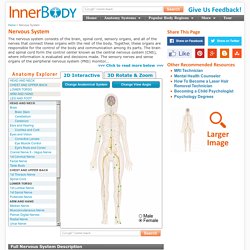
Efferent nerves in the PNS carry signals from the control center to the muscles, glands, and organs to regulate their functions. Nervous TissueThe majority of the nervous system is tissue made up of two classes of cells: neurons and neuroglia. Neurons. Neurons, also known as nerve cells, communicate within the body by transmitting electrochemical signals. Neurons look quite different from other cells in the body due to the many long cellular processes that extend from their central cell body. Gazzaniga, Consciousness & Brain Hemispheres.
The split brain: A tale of two halves. In the first months after her surgery, shopping for groceries was infuriating.

Standing in the supermarket aisle, Vicki would look at an item on the shelf and know that she wanted to place it in her trolley — but she couldn't. “I'd reach with my right for the thing I wanted, but the left would come in and they'd kind of fight,” she says. “Almost like repelling magnets.” Picking out food for the week was a two-, sometimes three-hour ordeal. Getting dressed posed a similar challenge: Vicki couldn't reconcile what she wanted to put on with what her hands were doing. In one crucial way, however, Vicki was better than her pre-surgery self. In June 1979, in a procedure that lasted nearly 10 hours, doctors created a firebreak to contain Vicki's seizures by slicing through her corpus callosum, the bundle of neuronal fibres connecting the two sides of her brain.
After about a year, Vicki's difficulties abated. Nature Podcast Michael Gazzaniga reflects on five decades of split-brain research No. Split brain behavioral experiments. Chapter 27 Frontal lobes bedside testing. The rise & fall of the prefrontal lobotomy – Neurophilosophy. LOBOTOMY (from the Greek lobos, meaning lobes of the brain, and tomos, meaning cut) is a psychosurgical procedure in which the connections the prefrontal cortex and underlying structures are severed, or the frontal cortical tissue is destroyed, the theory being that this leads to the uncoupling of the brain’s emotional centres and the seat of intellect (in the subcortical structures and the frontal cortex, respectively).
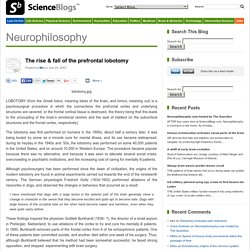
The lobotomy was first performed on humans in the 1890s. About half a century later, it was being touted by some as a miracle cure for mental illness, and its use became widespread; during its heyday in the 1940s and ’50s, the lobotomy was performed on some 40,000 patients in the United States, and on around 10,000 in Western Europe. The procedure became popular because there was no alternative, and because it was seen to alleviate several social crises: overcrowding in psychiatric institutions, and the increasing cost of caring for mentally ill patients.
025 The 4 Lobes of the Cerebrum and their functions. Everything you ever wanted to know about sensory deprivation chambers. A visual neglect patient. Temporal lobe. The temporal lobe is one of the four major lobes of the cerebral cortex in the brain of mammals.
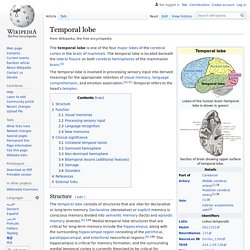
The temporal lobe is located beneath the lateral fissure on both cerebral hemispheres of the mammalian brain.[3] The temporal lobe is involved in processing sensory input into derived meanings for the appropriate retention of visual memory, language comprehension, and emotion association.[4]:21 Structure[edit] Medial temporal lobe[edit] The medial temporal lobe consists of structures that are vital for declarative or long-term memory. 067 The Anatomy and Functions of the Occipital and Temporal Lobes. The Man Who Mistook His Wife for a Hat. The book comprises twenty-four essays split into four sections, each dealing with a particular aspect of brain function such as deficits and excesses in the first two sections (with particular emphasis on the right hemisphere of the brain) while the third and fourth describe phenomenological manifestations with reference to spontaneous reminiscences, altered perceptions, and extraordinary qualities of mind found in mentally handicapped people.

Content[edit] The individual essays in this book include: In popular culture[edit] Peter Brook adapted Sacks's book into an acclaimed theatrical production, L'Homme Qui..., which premiered at the Théâtre des Bouffes du Nord, Paris, in 1993. What is the Hippocampus? By Dr Ananya Mandal, MD The hippocampus is a small region of the brain that forms part of the limbic system and is primarily associated with memory and spatial navigation.
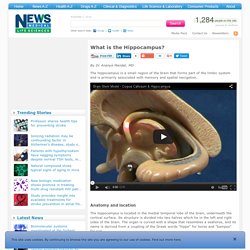
Anatomy and location The hippocampus is located in the medial temporal lobe of the brain, underneath the cortical surface. Its structure is divided into two halves which lie in the left and right sides of the brain. The organ is curved with a shape that resembles a seahorse, and its name is derived from a coupling of the Greek words "hippo" for horse and "kampos" for sea. History and discovery. Primitive Brain Is 'Smarter' Than We Think, MIT Study Shows. Primitive structures deep within the brain may have a far greater role in our high-level everyday thinking processes than previously believed, report researchers at the MIT Picower Center for Learning and Memory in the Feb. 24 issue of Nature.
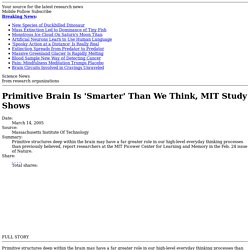
The results of this study led by Earl K. Miller, associate director of the Picower Center at MIT, have implications about how we learn. The new knowledge also may lead to better understanding and treatment for autism and schizophrenia, which could result from an imbalance between primitive and more advanced brain systems. Our brains have evolved a fast, reliable way to learn rules such as "stop at red" and "go at green. " Basic Parts of the Brain - Part 1 - 3D Anatomy Tutorial. Human Brain 2. Nervous System - Anatomy and Physiology. 063 The Divisions of the Nervous System. How Does Cocaine Affect The Brain? - How Drugs Work, Cocaine, Preview - BBC Three.